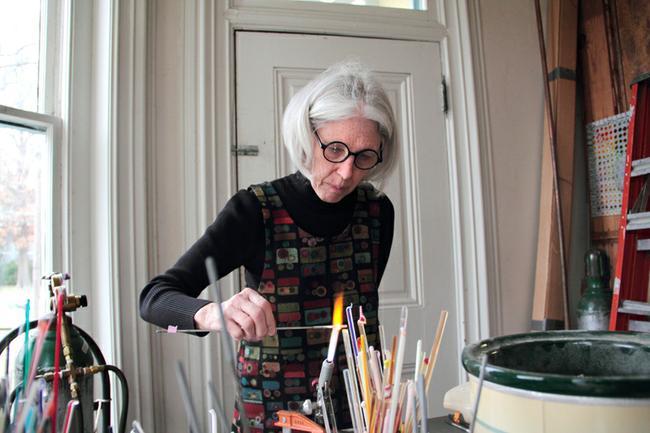
A rainbow dances across the wall, waving and twirling in the decorative windows’ brilliant light. Long icicle figures dangle and intertwine with the larger blotches of color to paint a collage around the warm shop. Within Village Glass Works’ crowded welcoming room, glass displays showcase handmade jewelry, marbles and other knickknacks. Aligning the walls are shelves of glass organized by shade, size and design. One cubbyhole contains glass stir sticks and another exhibits square plates, each with its own unique texture and movement.
Beyond the store hides a workshop that could match that of the North Pole. Shards of glass decorate the tabletops in a patchwork quilt fashion. Stain glass embellishes the windows as if to represent the beauty that can come from broken glass. A third room connects with the workshop; slightly smaller, it houses the kiln used for heating the glass and another table covered with utensils of every shape and form.
It is in this final room where the magic occurs.
With a warm smile, Molly Fiegel invited MOVE into her studio.
“I love how I can choose the effects of glass,” Molly Fiegel said. “I feel like I get to paint with someone else’s colors.”
Molly Fiegel’s parents bought the business when she was 13 years old and transformed it into the shop it is today. Working alongside her mother, Susie Fiegel, Molly Fiegel is both an artist and a merchant. All of their products are either made in their workshop or by local artists. Village Glass Works also offers public classes, supplies included, on how to make bead jewelry, stain glass and other arts.
MOVE was lucky enough to get its own private lesson.
“Stained glass requires the copper foil method,” Molly Fiegel explained.
Foil is wrapped around each piece of cut glass and solder is put over the lines to bring the glass together. Jewelry can also be made this way by sandwiching a picture (or piece of paper) between two pieces of thin glass, wrapping it with copper foil and soldering it to form a personalized pendant.
The most common technique is slumping, which creates vases, candleholders and other hollow objects. First, stack and fuse various colored glasses together to make one solid piece. Then, suspend the glass over a mold in the kiln so the glass melts down to shape the mold.
Fusing incorporates multiple pieces of textured glass that are melted together to form movement underneath the smooth surface of the finished product.
“This art is a magical alchemy of heat and glass,” Molly Fiegel said. “There’s really no way to learn, except through trial and error.”
Next, Susie Fiegel demonstrated how to make a glass bead using a torch. She heated the stainless steal mandrel (which is covered with bead release or clay) simultaneously with a colored glass rod. The original color of the glass will turn to a darker hue; this process is called striking. When the glass cools down it will return to its original color. Carefully stringing the glass on the mandrel, Susie Fiegel created a perfect ball of glass balanced on the mandrel.
Rotating the mandrel over the flame, the glass evens out to form a bead. Now through with the basics, the artist is free to design. A glass stringer (glass pulled into fine threads) is melted with the flame to add dots onto the outside of the bead. By pulling the bead out of the heat, the dots will cool slowly and keep their 3D form. However, if they continue to be heated, the dots will drop down and become flat 2D circles on the bead. After styling the bead, Susie Fiegel slowly cooled the hot glass by placing it in a container full of vermiculite, a mineral that releases tension in the bead to avoid cracking or breaking.
“The designs people create are astonishing,” she said. “Different sequences of dots and lines can turn into something so beautiful it makes your mouth drop open.”